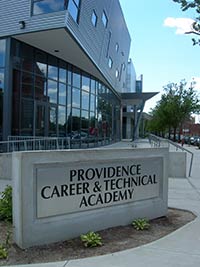view all Case Studies
Energy Recovery Helps School Meet 40 Percent Energy-Reduction Goal

The Providence (R.I.) Career and Technical Academy (PCTA) opened its doors to its first class of students on Sept. 2, 2009, after 212,000 square feet of new construction plus 72,000 square feet. of renovation in the previously existing Hanley Classroom Building. The project had to comply with the design requirements of the Northeast Collaborative for High Performance Schools, which includes 40 percent greater efficiency than ASHRAE 90.1 – 2001.
March 1, 2013 -
HVAC
The Providence (R.I.) Career and Technical Academy (PCTA) opened its doors to its first class of students on Sept. 2, 2009, after 212,000 square feet of new construction plus 72,000 square feet. of renovation in the previously existing Hanley Classroom Building. The project had to comply with the design requirements of the Northeast Collaborative for High Performance Schools, which includes 40 percent greater efficiency than ASHRAE 90.1 – 2001.
A major design directive to save on construction costs led PCTA to install a dual–temperature, two-pipe HVAC system. In contrast to the more common (and more expensive) four-pipe system where heating and cooling are available at any time, two-pipe systems cannot engage cooling coils to reduce humidity on cool, damp days while in the heating mode.
The solution to this dilemma was to install Airxchange energy recovery wheels containing a silica-gel desiccant for moisture transfer. By rotating between building exhaust and outdoor intake air streams, the wheels remove moisture from outdoor air on damp days and reject it into the exhaust air stream to keep indoor relative humidity at a comfortable level.
As part of energy recovery ventilators, the energy recovery wheels, in combination with of air-handling units, help to condition 45,215 CFM of outdoor air by continuously recycling the heating or cooling energy (depending on the season) from the exhaust air stream. On peak design days, the energy recovery wheels reduce the outdoor air load by as much as 80 percent.
In addition, the energy recovery wheels help reduce boiler operation by heating outside air enough to keep the school in the comfort zone. As a result, PCTA operates in the 43 kBtu/SF range, which is about 40 percent lower than the national average for all high schools, not just technical schools, according to the company.
Next
Read next on FacilitiesNet












